-- The Other Group --
the success and failure of arguments
countering alternative cosmologies
[from somewhere off the web, in July 2009]
Water Keys
CHAPTER 6
What is a water key used for? It's equipment that a municipality has for regulating the access of individual homes and larger buildings to its municipal water supply. If the main water pipe along a city or town street needs replacement or repair, municipal employees can tell the users 'we need to cut off your water supply for X number of hours.' Then, near where the private property line adjoins the municipal property there's a small metal cap on the ground, probably close to the edge of a lawn. Remove the cap and there's a hole in the ground at least about 4 feet deep in Canada. At the bottom is a shut-off valve which when turned will stop the flow of water from the municipality to the private owner's plumbing system. The water key is inserted in the hole, and when lowered to the bottom engages the shut-off valve from above. The T-bar shape at the top of the key provides additional leverage in turning the valve which may be stiff through lack of use. Why four feet down? Because in Canada the winters can produce considerable depths of snow. Like this:
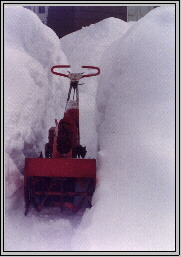
The temperatures in the 1960s and 1970s in Northern Ontario could drop to 40║ below zero║ Fahrenheit. It's somewhat less severe in the 21st century, but stilll lakes freeze over, and frost penetrates the ground to a depth of up to about 4 feet. That's why the Building Code here specifies that foundations of buildings must be at least 4 feet deep. This means they will be below the frost line in winter and the buildings will not 'heave.' The ground heaves because the water in it expands as it freezes, pushing the ground upwards, with anything on it or in it. That's why the water lines in this part of Canada are about 4 feet deep, and why water keys are about 4.5 to 5 feet long.
What has this to do with Egypt? The temperature range there is about 45║ to 95║ Fahrenheit, or about 8║ to 36║ Celsius, so water freeze-ups are not a problem with no likelihood of snow or frost. But there is something in common here: water. The Nile in Egypt is the longest river in the world at about 4100 miles. Egypt's entire civilization seems always to have relied on that river, its tributaries, and artificial irrigation from it, for crops and produce to grow in an otherwise desert-like terrain. Here's how it looks in modern times:
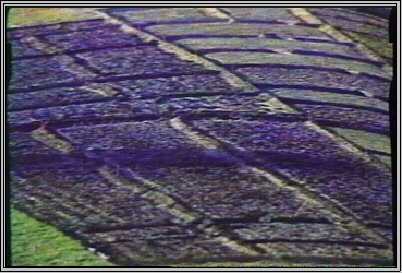
The result is a relatively consistent supply of produce to feed human agriculturalists and their livestock. We might add that wherever we find evidence for the presence of Immortals we apparently find early civilization with large rivers and irrigation: The Nile; Tigris and Euphrates; Meso America; South America; the Indus valley, in what is now Pakistan; the Yellow River, in what is now China. These civilizations seem to have been founded on a plentiful water supply coming from great rivers, necessarily controlled because such rivers can cause disastrous floods. The common element with the Canadian water key is the need to control a water supply. To understand more about how this happened in ancient times we need to look at how irrigation systems work. They were not so simple as you might think. There are different kinds but in ancient Egypt the basin system was used, so we'll look at that. First, the area to be irrigated is surrounded by embankments (that's why it's called a basin system). In ancient Egypt many of the basins were large, some covering 50,000 acres (that's over 78 square miles):
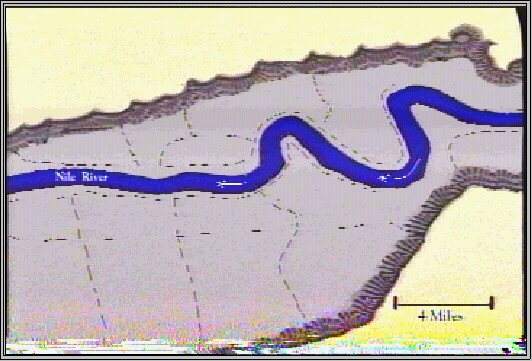
A main canal transports water from the river at a depth of about 3 to 4 feet. So now we have water about 4 feet deep again:
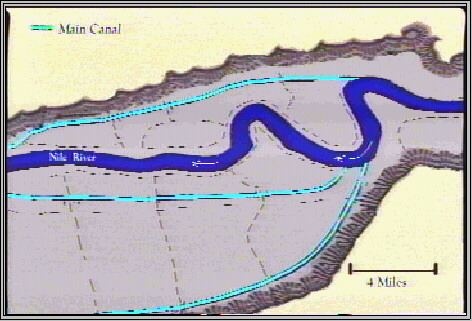
To operate the system you need high level canals:
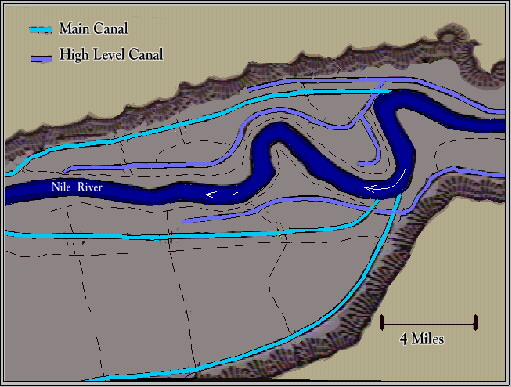
You also need a central basin canal:
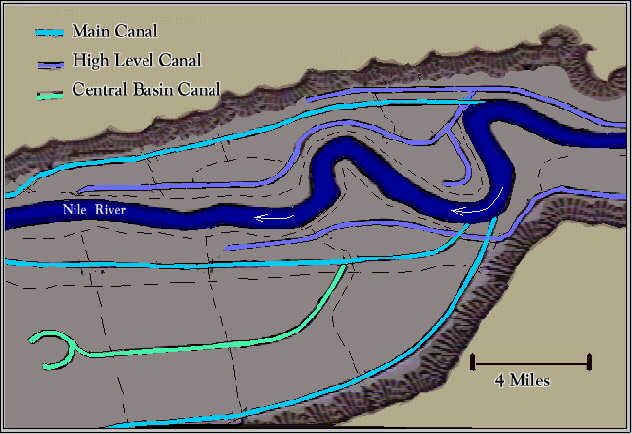
You need syphon aqueducts to pass the high or upper-level under the main canal near their head:
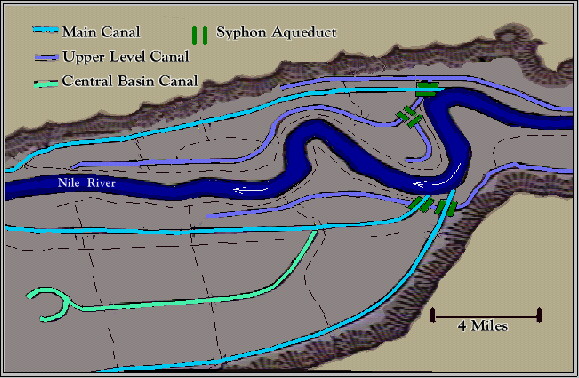
You need bridges fitted with sluice gates where each canal passes through an embankment:
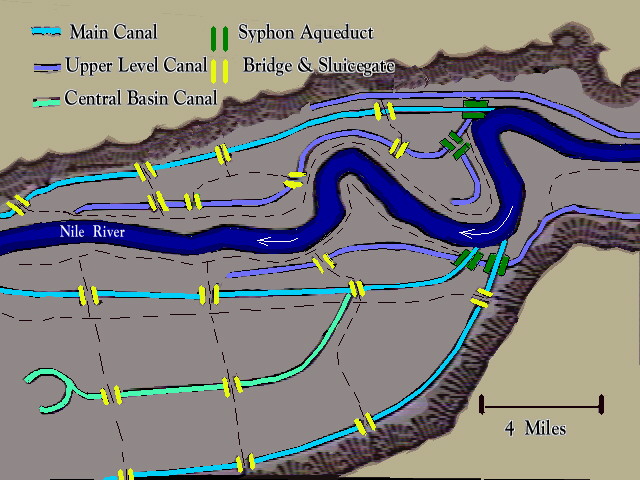
And you need escape weirs at the end of the system to return the water to the river:
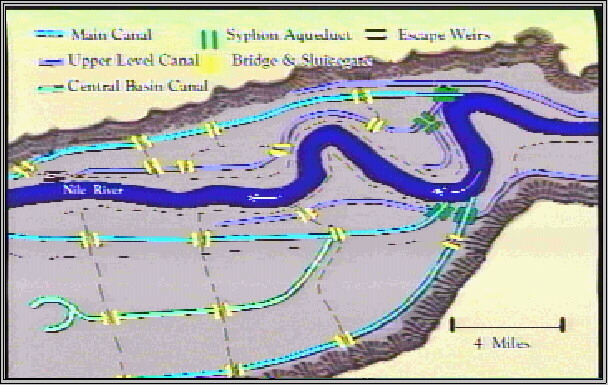
After a time the water is run off and the exposed area is seeded with crops which need no further watering.
The ancient Egyptians also had a 'Nilometer' to mark the relative level of flooding from season to season and year to year:
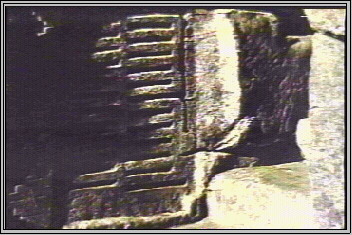
You can see that a competent engineer, skilled in water control, is required to organize and maintain a system like this. I suggest the water keys held by the male Immortals were used to control the sluice gates and escape weirs in complicated irrigation systems which they set up on the Nile river banks. As irrigation was the life blood of the economy we can see why the water key, the 'was sceptre,' first meant control, and later came to symbolize (the) well-being and happiness (of the people). Incidentally, the German word for water is 'wasser' and our own word is water, both of which have something in common with the 'was' sceptre.
URL of this page: https://saturniancosmology.org/othergroup/ch6.php
This page last updated: Friday, December 24th, 2010
[home page]
Feel free to email me with any comments or corrections.
jno (at) othergroup (dot) net
I'll be glad to add relevant comments or essaysCopyright © 2010 - 2025 Jno Cook
Permission to reprint in whole or in part is granted,
provided full credit is given.